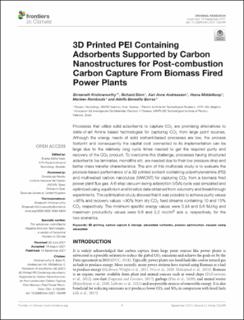| dc.contributor.author | Krishnamurthy, Shreenath | |
| dc.contributor.author | Blom, Richard | |
| dc.contributor.author | Andreassen, Kari Anne | |
| dc.contributor.author | Middelkoop, Vesna | |
| dc.contributor.author | Rombouts, Marleen | |
| dc.contributor.author | Borras, Adolfo Benedito | |
| dc.date.accessioned | 2022-03-23T15:01:06Z | |
| dc.date.available | 2022-03-23T15:01:06Z | |
| dc.date.created | 2022-01-03T12:40:22Z | |
| dc.date.issued | 2021 | |
| dc.identifier.citation | Frontiers in Climate. 2021, 3 1-14. | en_US |
| dc.identifier.issn | 2624-9553 | |
| dc.identifier.uri | https://hdl.handle.net/11250/2987155 | |
| dc.description.abstract | Processes that utilize solid adsorbents to capture CO2 are promising alternatives to state-of-art Amine based technologies for capturing CO2 from large point sources. Although the energy needs of solid sorbent-based processes are low, the process footprint and consequently the capital cost connected to its implementation can be large due to the relatively long cycle times needed to get the required purity and recovery of the CO2 product. To overcome this challenge, processes having structured adsorbents like laminates, monoliths etc. are needed due to their low pressure drop and better mass transfer characteristics. The aim of this multiscale study is to evaluate the process-based performance of a 3D printed sorbent containing polyethyleneimine (PEI) and multiwalled carbon nanotubes (MWCNT) for capturing CO2 from a biomass fired power plant flue gas. A 6-step vacuum swing adsorption (VSA) cycle was simulated and optimized using equilibrium and kinetics data obtained from volumetry and breakthrough experiments. The optimization study showed that it was possible to achieve purity values >95% and recovery values >90% from dry CO2 feed streams containing 10 and 15% CO2 respectively. The minimum specific energy values were 0.94 and 0.6 MJ/kg and maximum productivity values were 0.8 and 2.2 mol/m3 ads s, respectively, for the two scenarios. | en_US |
| dc.language.iso | eng | en_US |
| dc.publisher | Frontiers | en_US |
| dc.rights | Navngivelse 4.0 Internasjonal | * |
| dc.rights.uri | http://creativecommons.org/licenses/by/4.0/deed.no | * |
| dc.subject | vacuum swing adsorption | en_US |
| dc.subject | process optimisation | en_US |
| dc.subject | adsorption isotherms | en_US |
| dc.subject | carbon capture & storage | en_US |
| dc.subject | 3D printing | en_US |
| dc.title | 3D Printed PEI Containing Adsorbents Supported by Carbon Nanostructures for Post-combustion Carbon Capture From Biomass Fired Power Plants | en_US |
| dc.type | Peer reviewed | en_US |
| dc.type | Journal article | en_US |
| dc.description.version | publishedVersion | en_US |
| dc.rights.holder | Copyright © 2021 Krishnamurthy, Blom, Andreassen, Middelkoop, Rombouts and Borras. This is an open-access article distributed under the terms of the Creative Commons Attribution License (CC BY). The use, distribution or reproduction in other forums is permitted, provided the original author(s) and the copyright owner(s) are credited and that the original publication in this journal is cited, in accordance with accepted academic practice. No use, distribution or reproduction is permitted which does not comply with these terms. | en_US |
| dc.source.pagenumber | 1-14 | en_US |
| dc.source.volume | 3 | en_US |
| dc.source.journal | Frontiers in Climate | en_US |
| dc.identifier.doi | 10.3389/fclim.2021.733499 | |
| dc.identifier.cristin | 1973692 | |
| dc.source.articlenumber | 733499 | en_US |
| cristin.ispublished | true | |
| cristin.fulltext | original | |
| cristin.qualitycode | 1 | |

